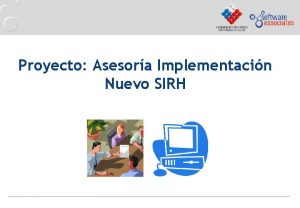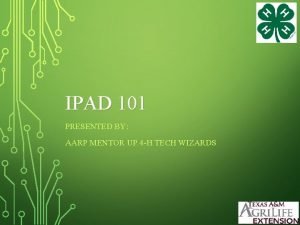IPad IPhone and IPod Applications for Special Education

- Slides: 1

IPad, IPhone, and IPod Applications for Special Education Practitioners: Evidence-Based Practice Saeed Alqahtani University of Iowa, Iowa City, IA (USA) Introduction Results Examples With the increase in the use of new technologies (NT) in today's society, it is important to investigate their usefulness in special education settings. Traditional technology (e. g. , desktop and laptop computers) has been used to support special education teachers in improving students’ performance in a variety of skills; though, the use of NT (e. g. , i. Pad, i. Phones, and i. Pod) may enhance this goal and maximize students learning activity, engagement, and motivation. Purpose The purpose of this literature review is to evaluate how NTs have been used in research in order to highlight their effectiveness for evidence-based practice. Thirty studies that used NT and targeted students with developmental disabilities (DDA) were obtained, reviewed, and synthesized. Contact Saeed Alqahtani The University of Iowa Ph. D. Candidate Special Education 239 Lindquist Center Iowa City, IA 52242 saeedsaad-alqahtani@uiowa. edu Discussion All studies proved that handheld devices could be used effectively for individuals with developmental disabilities in a variety of skills including academic, social, communication, employment, and independent skills. In addition, the results indicated that students and teachers socially accept handheld devices. Handheld devices can increase student engagement which results in performance improvement. Besides these applications for students, teachers can use these devices to teach skills or to deliver instructions. It could be used alone or combined with teaching strategies. Also, teachers are encouraged to use these applications for elementary age students because they can interact positively with handheld devices (Gulchak, 2008; Bernard et al. , 2001). Implications In order to promote the effectiveness of technology based intervention the following suggestions should be considered: • Combining strategies to address each skill is an effective way of aiding students. For example, two possibilities would be combining video modeling with self-monitoring and combining game playing with problem solving. • Animations, colors, and pictures should be used when teaching young children. • Involving students in their own intervention programs is effective. • Teachers should be aware of interactions with students who use devices in classrooms so other students do not interrupt. • Improving social skills leads to improved academic skills. Figure 1. example of phonological awareness app References Bernard-Opitz, V. , Sriram, N. N. , & Nakhoda-Sapuan, S. (2001). Enhancing social problem solving in children with autism and normal children through computer-assisted instruction. Journal Of Autism & Developmental Disorders, 31, 377. Chai, Z. , Vail, C. O. , & Ayres, K. M. (2014). Using an ipad application to promote early literacy development in young children with disabilities. The Journal of Special Education, Flores, M. , Musgrove, K. , Renner, S. , Hinton, V. , Strozier, S. , Franklin, S. , et al. (2012). A comparison of communication using the Apple i. Pad and a picturebased communication system. Augmentative and Alternative Communication, 28, 74– 84. Gulchak, D. (2008). Using a Mobile Handheld Computer to Teach a Student with an Emotional and Behavioral Disorder to Self-Monitor Attention. Education & Treatment Of Children (ETC), 31, 567 -581. Hammond, D. L. , Whatley, A. D. , Ayres, K. M. , & Gast, D. L. (2010). Effectiveness of video modeling to teach i. Pod use to students with moderate intellectual disabilities. Education and Training in Autism and Developmental Disabilities, 45, 525– 538. Project Tomorrow. (2013). From chalkboards to tablets: The emergence of the K-12 digital learner. Retrieved from http: //www. tomorrow. org/speakup/pdfs/SU 12 -Students. pdf Raine, L. (2013, June 6). Cell phone ownership hits 91% of adults. Pew Research Center. Retrieved from http: //www. pewresearch. org/facttank/2013/06/06/cell-phone-ownership-hits-91 -of-adults/van Laarhoven, T. , Johnson, J. W. , van Laarhoven-Myers, T. , Grider, K. L. , & Grider, K. M. (2009). The effectiveness of using a video i. Pod as a prompting device in employment settings. Journal of Behavioral Education, 18, 119– 141.

